Every year, spring comes around and brings flowers, warmer weather, and green leaves to the trees, but that’s not all spring brings. For example, you may notice small red bugs on concrete surfaces near your home. They’re bright red, about the size of pinpricks, and many people don’t know what they are.
What are tiny red bugs on concrete? These tiny little red bugs on concrete go by many names. While most people know them as clover mites, others mistakenly call them spider mites. Their scientific name is Bryobia praetiosa Koch, and they’re not insects. They’re arachnids that are more closely related to ticks and spiders than bugs.

In this article, we’ll provide you with everything you ever (or never) wanted to know about clover mites, including:
- What they look like
- Whether or not they’re dangerous
- What they eat
- Where they come from
- And more!
What Are the Little Red Bugs on Concrete?
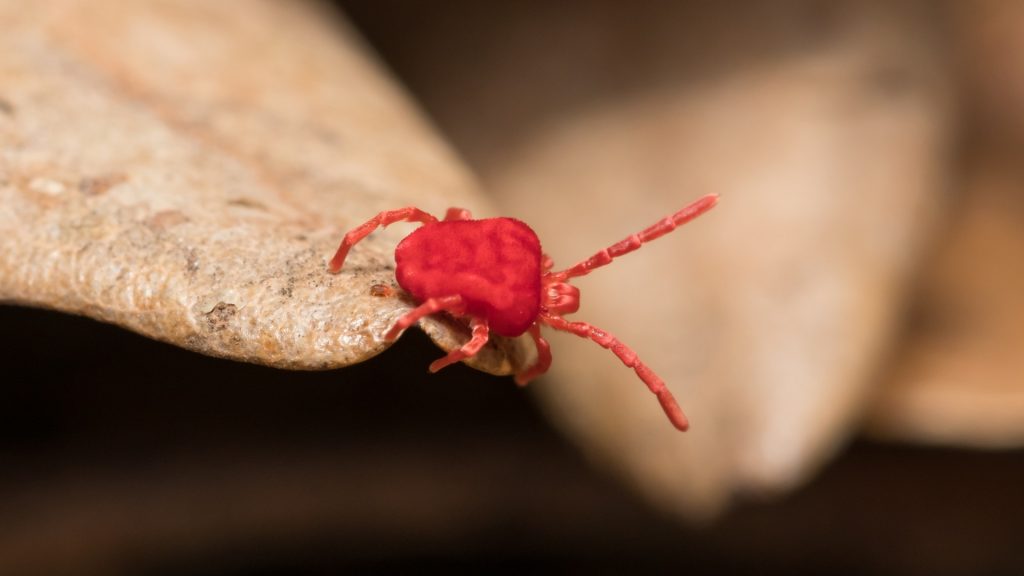
Bryobia praetiosa Koch, more commonly known as clover mite, goes by many names. Some people refer to them as concrete bugs or concrete mites. Others call them red clover mites or red spider mites.
All of these names are pretty accurate to what the clover mite is, except for the last one. Clover mites are not spider mites. Other less common names include:
- Red mites
- Brown mites
- Brown clover mites
- Window mites
- Red velvet mites
- Rain bugs
Where Do Clover Mites Come From?
Clover mites are practically everywhere. You can find them in all 48 of the contiguous states of the United States, as well as in Asia, Africa, Australia, Europe, and South America.
They’re abundant little pests, and unlike many other mites, they prefer cooler weather between 50°F and 75°F (10°C and 23.89°C), so you’ll see them most often in the early spring and other cooler times throughout the year.
What Do Clover Mites Look Like?
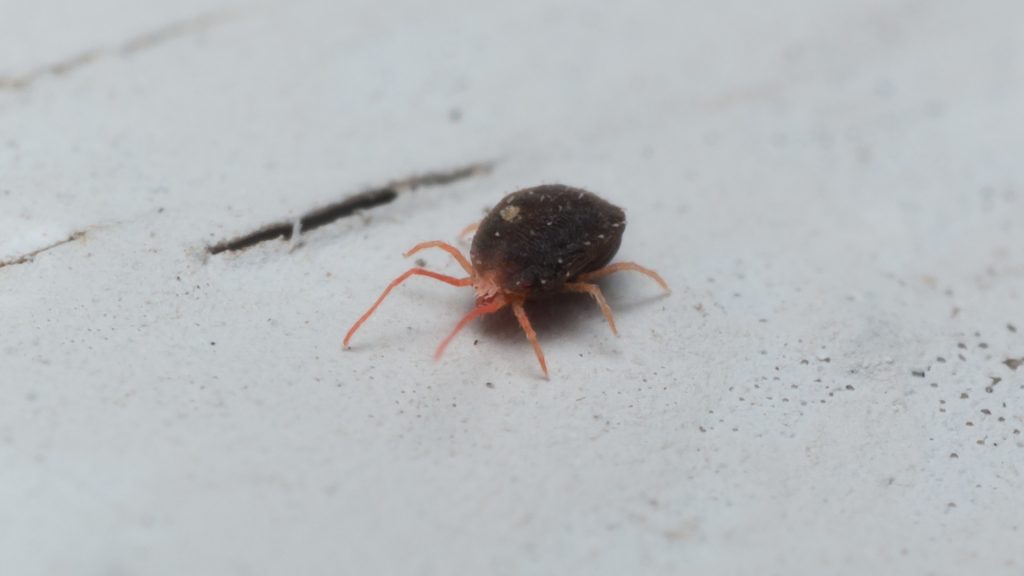
If you’re picturing a tiny red spider, you’re not far off the mark; although, they look a bit more like ticks than spiders.
Clover mites are usually bright red, although some are brown or green. They’re less than a millimeter (0.04 inches) long and have eight tiny legs. Unlike other mites, their front legs are longer than the other six.
Why Are Clover Mites Red?
First of all, not all clover mites are red. As we mentioned above, some are brown or even green. However, clover mites that are red get their color from the pigments in their body fluids. Keep that in mind if you crush one; the red stain on the wall or your finger is from the mite’s natural pigments. It’s not blood.
Do Clover Mites Fly?
Clover mites don’t fly. At no stage in their development do they have wings, so it would be impossible for them to do so.
Can Clover Mites Jump?
Clover mites aren’t known for their jumping ability either. Despite their unusually long front legs, they aren’t jumpers or hoppers. Instead, they stick to walking to get around. They are quick, though, thanks in large part to their extremely long front legs, which are longer than their entire bodies and twice as long as the other six legs.
Are Clover Mites Dangerous?
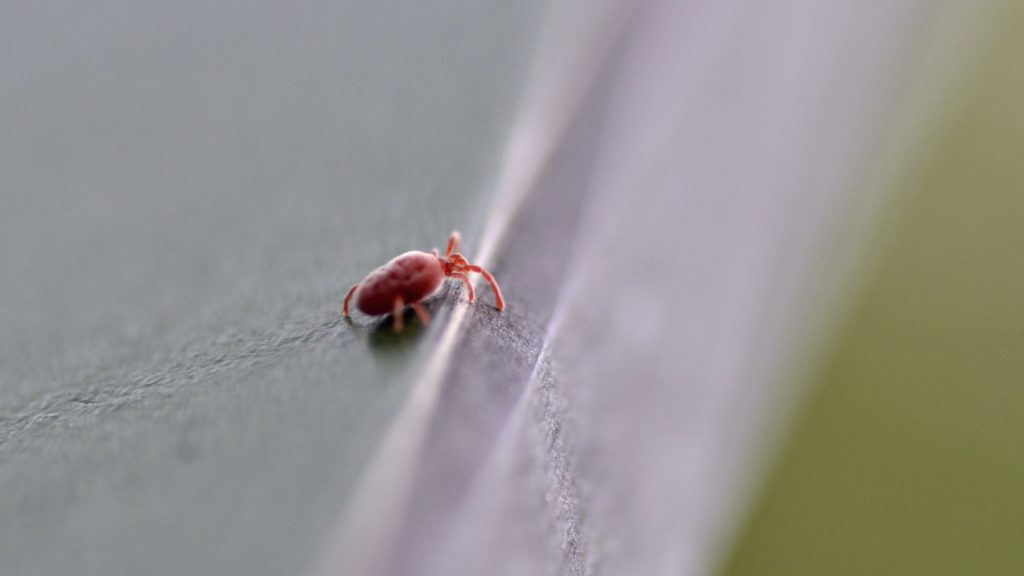
Let us put your mind at ease. Clover mites pose no hazard to humans or domestic animals. Furthermore, they don’t do any structural damage to homes, and they don’t feed on human or pet food, so you don’t have to worry about them getting into your pantry.
The biggest problem clover mites cause is staining. When you smash the tiny things, they stain whatever they’re standing on with their red pigment.
Do Clover Mites Bite?
People often wonder whether or not clover mites bite. Fortunately, they don’t bite, and they don’t carry transmittable diseases. So, you don’t have anything to worry about.
What Do Clover Mites Eat?
As you might have guessed from their name, clover mites eat clover, along with most other types of grass and weeds. However, they also eat:
- Flowers
- Trees
- Shrubs
- New shoots and buds
- Crops
- Mulch
They feed by biting along the length of the plant, sucking nourishment from it. They make silvery trails, similar to snail trails, along the plants they feed on, and that trail is sometimes easier to see than the mites themselves.
Clover Mites Life Cycle
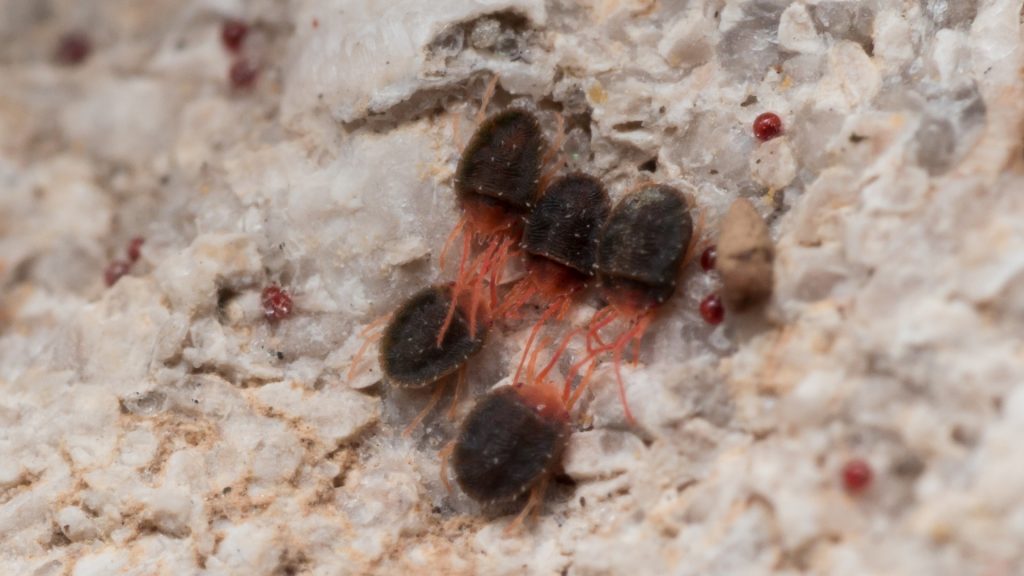
Clover mites go through a four-stage development process. The stages are as follows:
- Egg
- Larva
- Nymph
- Adult
If you’re more of a visual person, there’s an informative image of a mite’s life cycle on the North Carolina State University Extension page. It represents mites in general, but clover mites have the same stages.
Clover Mite Eggs
Most states in the U.S. are home to at least two generations of clover mites each year. They usually lay their eggs in the spring and fall months, but if they lay them too late in the spring, the eggs will lie dormant throughout the summer until the weather cools down once more in the fall.
Clover Mite Larva
Depending on when the clover mites laid their eggs, it can take them mere hours or a whole week to hatch and enter the larval stage. At this point, the larvae, which have only six legs, feed for a few days and then look for shelter. Once they find it, they go dormant until the molting process begins. This cycle of feeding, finding shelter, and molting happens twice.
Clover Mite Nymph
After the molting, clover mites enter the nymph stage of their development, which is when they grow their final pair of legs and develop the typical mite body. There are two nymphal stages, as well, before they become fully grown adult clover mites. The entire maturing process takes between 14 and 30 days.
Clover Mite Adult
As far as scientists know, there are no adult male clover mites. All adults are females, and they don’t need males to reproduce. Instead, the females reproduce through parthenogenesis.
Parthenogenesis is the “spontaneous development of an embryo from an unfertilized egg cell.” Each female lays approximately 70 eggs.
How To Get Rid of Red Bugs on Concrete?
So, how do you get rid of those tiny red mites on concrete? You could squish them, but that would take a lot of time. Luckily, there’s a better way.
If the clover mites are outside, using a pesticide made with malathion works best. We recommend using Southern Ag Broad Spectrum Insecticide. It’s effective and safe for your plants.
- CONTROLS: Aphids, scale, worms, japanese beetle, horn flies,...
- Insecticide
- USE ON: Citrus, ornamentals, listed vegetables, listed fruit...
- APPLICATION: As a full coverage foliar spray
If the clover mites are inside your home, you should use something a little more natural and organic. If that’s the case, try EcoRaider Insect Killer. It’s safe for people, plants, and animals, and it’ll take care of the clover mites at every stage of their development.
- 【Dual-Function Kills & Repels】:This dual-action plant based...
- 【One Spray & You don’t See Them Again】:Spray on active...
- 【Proven by Published University Studies】:EcoVenger...
- 【Natural & Non-Toxic but Highly Efficacious】:Contains no...
- 【Your Safety is Our Priority】:EcoVenger goes through strict...
How To Get Rid of Clover Mites on Concrete Naturally?
There are several ways to get rid of clover mites naturally. You can vacuum them or gently clean the area they’re inhabiting with a sponge and a mixture of dish detergent, essential oils, and water. That’ll get rid of the mites, and the smell will dissuade them from returning. Other natural remedies include:
- Using diatomaceous earth
- Natural Product - Composed of 10lbs of 100% ground freshwater...
- OMRI Listed - Listed with the Organic Minerals Research...
- Powder Duster Included - Powder duster in the bag for easy and...
- Made in the USA – Mined in Nevada and packaged in Georgia
- Supports a Great Cause - Harris donates 10% of profits to support...
- Using boric acid
- BORIC ACID: Boric acid, also known as boracic acid or orthoboric...
- MULTIPURPOSE CLEANING: Versatile in nature, this fine powder is a...
- INDUSTRIAL GRADE: With its industrial-grade strength, our Boric...
- LAUNDRY USAGE: Elevate your laundry game by incorporating this...
- DEODORIZING POWER: Experience the deodorizing capabilities of our...
- Using sticky traps to catch them in frequently areas
- Effective 20 Pack Sticky. Specially designed for flying plant...
- Great for attracts whiteflies, fungus gnats, blackflies, thrips,...
- Made of ECO friendly materials, safe and Non-toxic, product...
- Dimension: 20 Pack 6*8 inches ; Wire Ties(8 inches) included.
- Easy to Use, UV Resistant adhesive will not dry up,...
- Using a mixture of vinegar and water
- Cooking - Spices up dipping sauces, develops flavor, makes...
- Cleaning - Yes! White Vinegar for cleaning works fantastically.
- Family Owned & Family Run - Here at Lucy's, we seek to achieve...
- Sprinkling baking soda around areas you want to protect
- PURE BAKING SODA - 100% Sodium Bicarbonate
- GREAT FOR BAKING - Use in you favorite recipes
- VERSATILE AND EFFECTIVE - Works as a house hold cleaner and...
- EASY TO USE - Shake or pour style lid is convinent for baking or...
- 12 oz can of Clabber Girl Baking Soda
What Plants Attract Clover Mites?
Clover mites don’t just stick to the concrete areas around your home. You’ve probably also noticed these tiny red bugs on plants in your yard. That’s because plants are their food source. They love clover and regular lawn grass. They also enjoy:
- Shrubs
- Weeds
- Ornamental plants
- Trees
- Crops
Do Clover Mites Harm Plants?
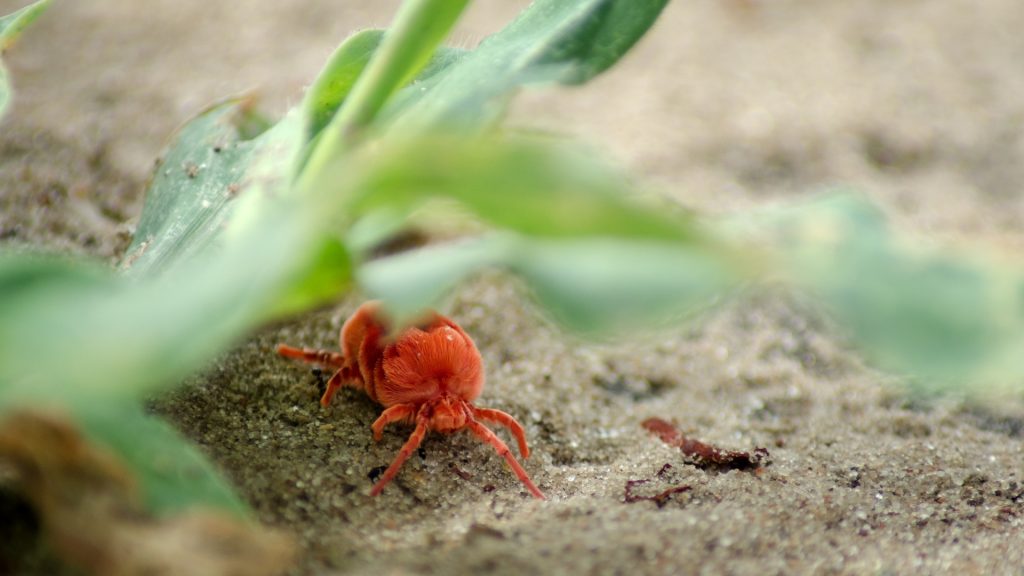
Because they’re so small, it’s difficult for one or two mites to do any real damage to a plant from which they’re feeding.
However, as you may recall, each female lays up to 70 eggs, and all adult clover mites are female. That adds up to a lot of eggs and hatching mites. In those numbers, yes, clover mites can do some serious damage to your yard and plants.
Summary
If you suddenly find yourself overrun with tiny red insects, don’t panic. They may look scary, but clover mites aren’t dangerous to you, your children, or your pets. The most harm they can do is staining your walls, clothes, and furniture if you accidentally smash them.
They tend to come in large numbers, though, so if you’re concerned about what they might do to your landscaping, it’s best to get rid of them early. There are plenty of ways to do that, using either insecticides or natural methods. Of course, if all else fails, you can always call an exterminator.
List of Sources
Gomez, C., Mizell III, R.F. (2008). Clover Mite – Bryobia praetiosa Koch. University of Florida.
Shetlar, D., Bloetscher, B. (2010). Clover Mites. Ohioline, Ohio State University Extension.
Powell, P.K. Clover Mites. West Virginia University, Extension Service.
Davis, H.N., Whitworth, R.J. (2018). Household Pests of Kansas. Kansas State University.
Karren, J. B. (2000). Clover Mites. Utah State University, Cooperative Extension.
Boyd, D., Zungoli, P.A. (2020). Clover Mites. Clemson Cooperative Extension.
- How to Get Rid of Copperheads | Practical Guide - August 27, 2023
- How to Get Rid of Corn Snakes | What Makes Them Aggressive? - August 27, 2023
- How to Get Rid of Alligators | Safety Measures and Removal Methods - July 16, 2023







